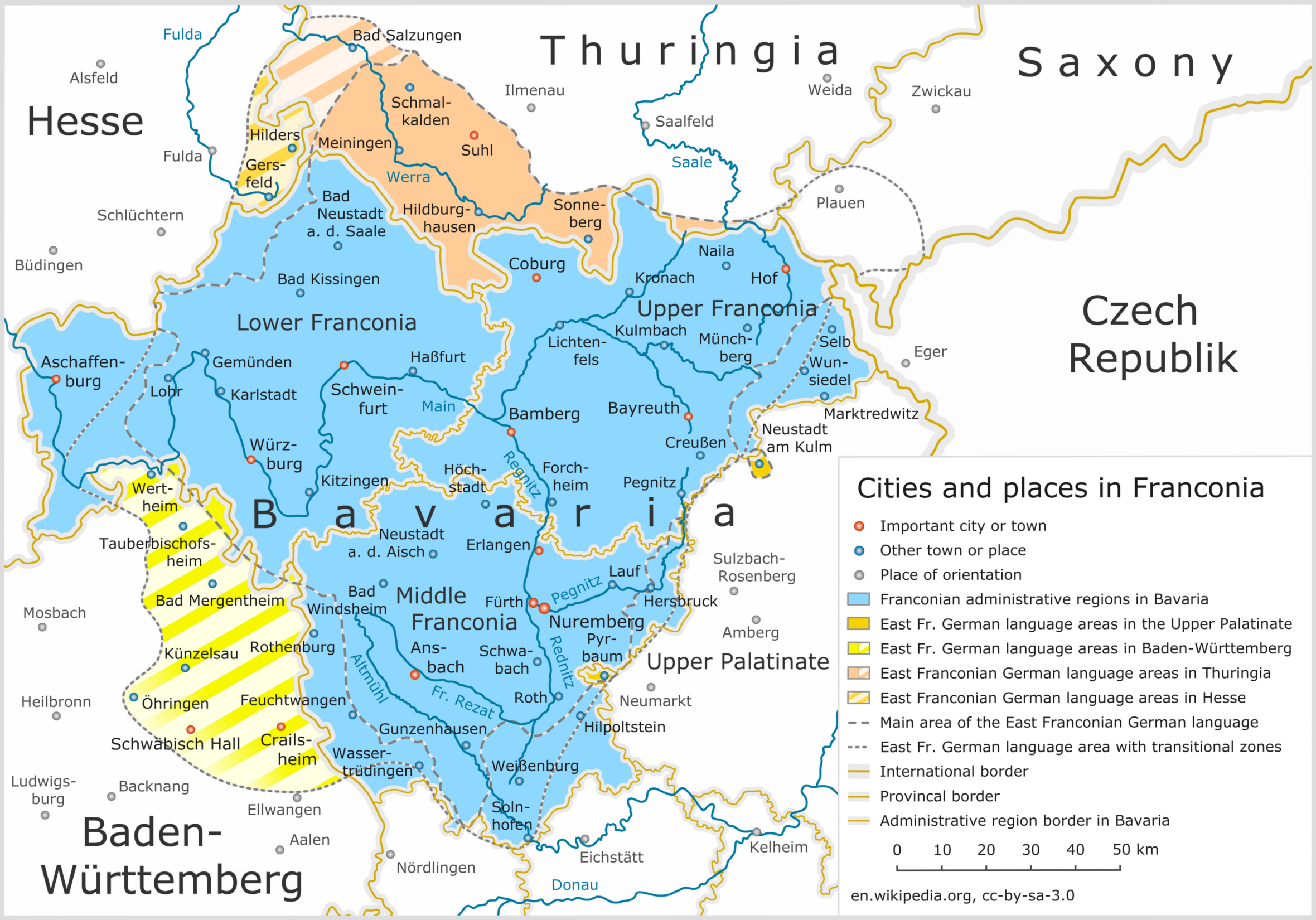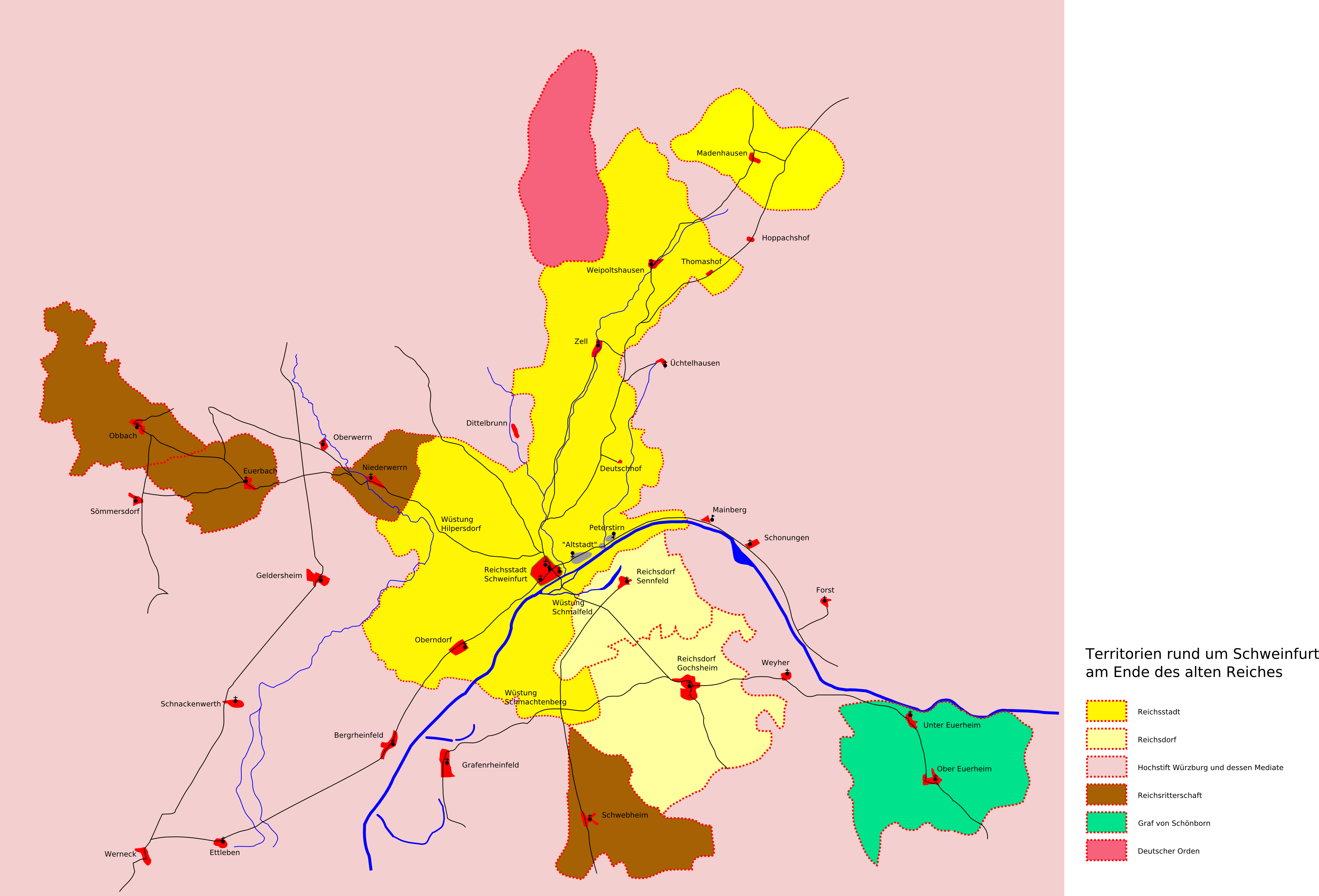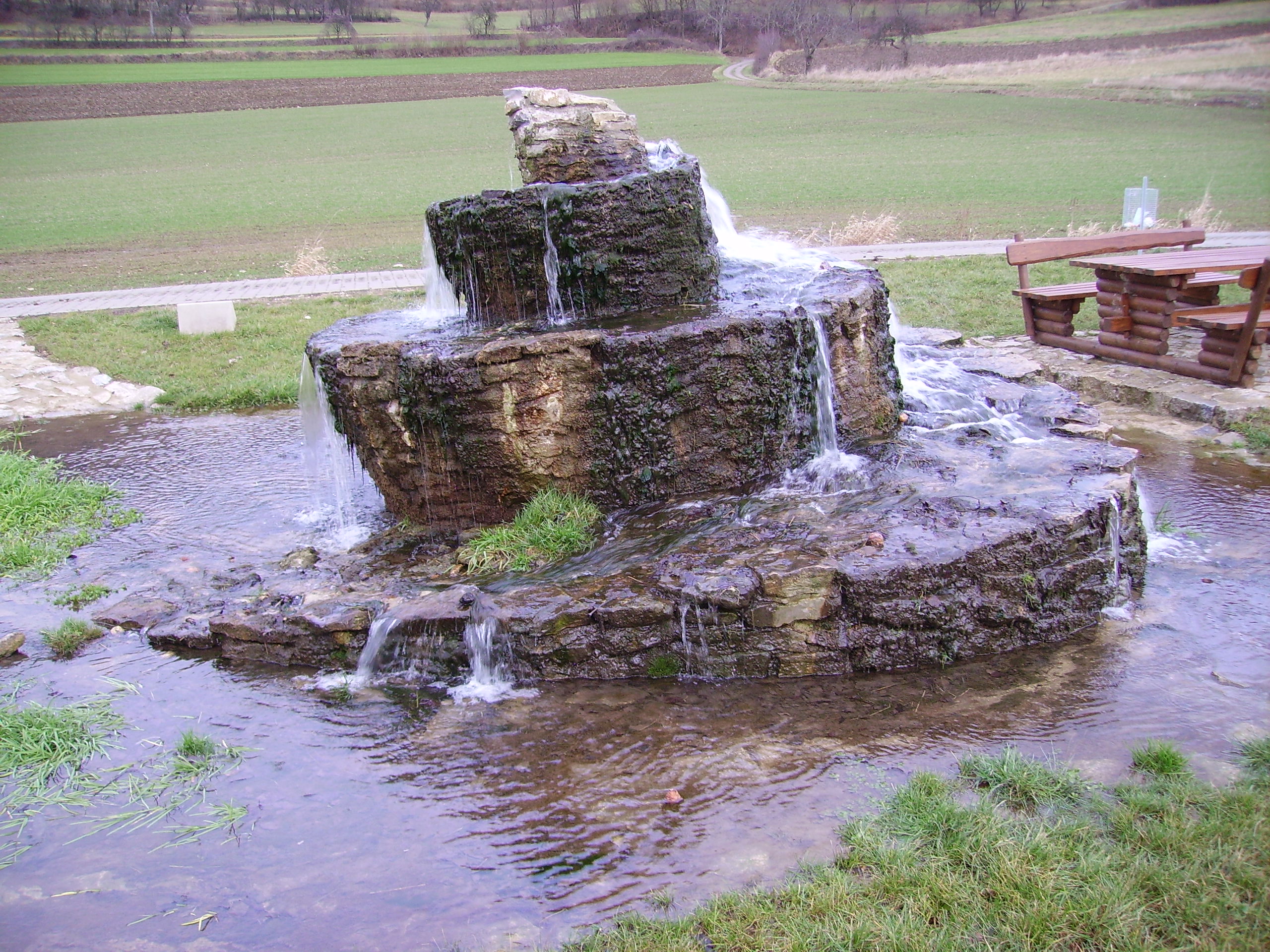|
Steigerwald
The Steigerwald () is a hill region up to in the Bavarian-Franconian part of the South German Scarplands between Würzburg and Nuremberg. It is part of the Keuper Uplands, and within it, it is continued to the north-northeast and right of the river Main, by the Haßberge, and to the south-southwest by the Franconian Heights. Part of the region is a designated as the Steigerwald Nature Park. Geography Location The Steigerwald lies at the junction of the Bavarian provinces of Lower, Middle, and Upper Franconia, the tripoint being marked by the Dreifrankenstein. It is located between the cities of Bamberg, Schweinfurt, Würzburg, and Nuremberg. In the north, it is bounded by the course of the river Main, and in the east by the river Regnitz. Its southern boundary is formed by the river Aisch, and in the west by the Main again and a line from Marktbreit via Uffenheim to Bad Windsheim. The Steigerwald covers the territories of six counties: Bamberg, Erlangen-Höchs ... [...More Info...] [...Related Items...] OR: [Wikipedia] [Google] [Baidu] |
Steigerwald Nature Park
On 8 March 1988 the Bavarian State Ministry for State Development and the Environment designated an area of in the Steigerwald in North Bavaria, Germany, as the Steigerwald Nature Park (). About half the area consists of protected landscapes. The nature park is run by the Steigerwald Tourist Association and Steigerwald Nature Park (''Tourismusverband Steigerwald und Naturpark Steigerwald e.V.''). The landscape is characterised by deciduous and pine forests, ponds and vineyards. Location The Steigerwald hill range straddles the Bavarian provinces of Lower, Middle and Upper Franconia and surrounds their tripoint which is marked by the Dreifrankenstein ("Three Franconias Stone"). It is located between the cities of Bamberg, Schweinfurt, Würzburg and Nuremberg. To the north it is bounded by the course of the Main and to the east by the Regnitz. Its southern boundary is formed by the Aisch and to the west the Main again and an extension of the line from Marktbreit via U ... [...More Info...] [...Related Items...] OR: [Wikipedia] [Google] [Baidu] |
Franconia
Franconia ( ; ; ) is a geographical region of Germany, characterised by its culture and East Franconian dialect (). Franconia is made up of the three (governmental districts) of Lower Franconia, Lower, Middle Franconia, Middle and Upper Franconia in Bavaria, the adjacent, East Franconian, Franconian-speaking South Thuringia, south of the Thuringian Forest—which constitutes the language boundary between Franconian and Thuringian—and the eastern parts of Heilbronn-Franconia in Baden-Württemberg. Those parts of the Vogtland lying in Saxony (largest city: Plauen) are sometimes regarded as Franconian as well, because the Vogtlandian dialects are mostly East Franconian. The inhabitants of Saxon Vogtland, however, mostly do not consider themselves Franconian. On the other hand, the inhabitants of the Hessian dialect, Hessian-speaking parts of Lower Franconia west of the Spessart (largest city: Aschaffenburg) do consider themselves Franconian, although not speaking the dialect. He ... [...More Info...] [...Related Items...] OR: [Wikipedia] [Google] [Baidu] |
Scheinberg
The Scheinberg is a hill, ,{{GeoQuelle, DE, BFN-Karten and the highest point in the Steigerwald, a hill range in southern Germany. It lies northeast of Ippesheim in the county of Neustadt an der Aisch-Bad Windsheim in Middle Franconia. To the north runs the border with the Lower Franconian province of Kitzingen Kitzingen () is a town in the Germany, German state of Bavaria, capital of the Kitzingen (district), district Kitzingen. It is part of the Franconia geographical region and has around 21,000 inhabitants. Surrounded by vineyards, Kitzingen County i .... References Hills of Bavaria ... [...More Info...] [...Related Items...] OR: [Wikipedia] [Google] [Baidu] |
Schweinfurt Basin
Schweinfurt ( , ; ) is a city in the district of Lower Franconia in Bavaria, Germany. It is the administrative centre of the surrounding district (''Landkreis'') of Schweinfurt and a major industrial, cultural and educational hub. The urban agglomeration has 100,200 (2018) and the city's catchment area, including the Main-Rhön region and parts of South Thuringia, 759,000 inhabitants. Schweinfurt was first documented in 791 and is one of the oldest cities in Bavaria. Around 1000 the Margraves of Schweinfurt controlled large parts of northern Bavaria. From the 12th century until 1802 Schweinfurt was a Free imperial city within the Holy Roman Empire; around 1700 it became a centre of humanist activity, and in 1770 the city's 250-year industrial history began. During World War II, the Americans suffered their biggest air defeat over Schweinfurt in the Second Raid on Schweinfurt ''(Black Thursday)''. On 11 April 1945, the US Army inva ... [...More Info...] [...Related Items...] OR: [Wikipedia] [Google] [Baidu] |
Schweinfurt
Schweinfurt ( , ; ) is a town#Germany, city in the district of Lower Franconia in Bavaria, Germany. It is the administrative centre of the surrounding Schweinfurt (district), district (''Landkreis'') of Schweinfurt and a major industrial, cultural and educational hub. The urban agglomeration has 100,200 (2018) and the city's catchment area, including the Main-Rhön region and parts of South Thuringia, 759,000 inhabitants. Schweinfurt was first documented in 791 and is one of the oldest cities in Bavaria. Around 1000 the Margraves of Schweinfurt controlled large parts of northern Bavaria. From the 12th century until 1802 Schweinfurt was a Free imperial city within the Holy Roman Empire; around 1700 it became a centre of Renaissance Humanism, humanist activity, and in 1770 the city's 250-year industrial history began. During World War II, the Americans suffered their biggest air defeat over Schweinfurt in the Second Raid on Schweinfurt ''(Black Thursd ... [...More Info...] [...Related Items...] OR: [Wikipedia] [Google] [Baidu] |
Landkreis Schweinfurt
Schweinfurt is a (district) in the northwestern part of Bavaria, Germany. Neighboring districts are (from the north clockwise) Bad Kissingen, Rhön-Grabfeld, Haßberge, Bamberg, Kitzingen, Würzburg and Main-Spessart. The district-free city Schweinfurt is surrounded by the district. Geography Primary rivers in the district are the Main and the Wern. The district is located between several hill chains - Haßberge to the east, the Rhön in the northwest, the Spessart to the west and the Steigerwald in the southeast. History The area of the district became part of Bavaria in 1814. In 1972 parts of the previous district Gerolzhofen (including the town Gerolzhofen) were merged with the district. Archaeology In July 2022, archaeologists announced the discovery of a 3000-year-old clay figurine that might represent a prehistoric female water goddess. The 19 cm tall clay figurine's carefully modeled eye sockets, nose, lips, and chin are obviously visible and attractive. There are ... [...More Info...] [...Related Items...] OR: [Wikipedia] [Google] [Baidu] |
Keuper Uplands
The Keuper Uplands ( or, more rarely ''Keuperwaldberge'') are part of the South German Scarplands and cover an area of about 3,200 square kilometres. The following regions belong to the Keuper Uplands (from southwest to northeast): the Kleiner Heuberg, Rammert, Schönbuch, Glemswald, Stromberg and Heuchelberg, Schurwald and Welzheim Forest, Swabian-Franconian Forest, Franconian Heights, Steigerwald and Hassberge. The southwesternmost Keuper escarpment in the area of the Baar (region), Baar does not have its own name because of its small size. Natural region divisions The Keuper Uplands are divided into three natural region major unit groups which, in turn, are subdivided into major units, shown underneath in each case with three-figure index numbers (units of which only small areas lie on keuper are in italics) and ridges that are orographically separated from one another (basins and ridges on the perimeters have been omitted):Various authors: ''Geographische Landesaufnahme: Han ... [...More Info...] [...Related Items...] OR: [Wikipedia] [Google] [Baidu] |
Franconian Heights
The Franconian HeightsBavarian State Chancellery, ''Information about Bavaria'', 1981, p. 11. () are a hill ridge, up to , in Bavaria and Baden-Württemberg in South Germany. Location and boundaries The Franconian Heights lie in the west of Franconia on either side of the border between Bavaria in the east (with the districts of Neustadt a.d.Aisch-Bad Windsheim and Ansbach) and Baden-Württemberg in the west ( Schwäbisch Hall and a small area of the Ostalbkreis). The larger part lies in Bavaria; the markedly smaller southwestern element is in Baden-Württemberg. It includes the southern part of the so-called Crailsheim Hardt (''Crailsheimer Hardt''), which extends in an arc around the town of Crailsheim from the ramp of the A 6 northeast of Satteldorf in the north as far as Jagst near Stimpfach in the south, where it transitions into the Virngrund. It also includes the little basin of the upper ''Zwergwörnitz'' to the southeast, near Kreßberg. The Franconian Heights, ... [...More Info...] [...Related Items...] OR: [Wikipedia] [Google] [Baidu] |
Franconian Keuper-Lias Land
The Franconian Keuper-Lias Plains or Franconian Keuper-Lias LandsDickinson, Robert E (1964). ''Germany: A regional and economic geography'' (2nd ed.). London: Methuen, p. 83. . () are a major natural region in the South German Scarplands in Upper Franconia and to a lesser extent in the north, in the Thuringian district of Hildburghausen. As the name indicates, the term embraces both the Keuper landscapes (including the well-known parts of the Keuper Upland Haßberge, Steigerwald and Franconian Heights) and lias landscapes (Black Jurassic) in Franconia. In addition, the fore-land of the Franconian Jura (''Vorland der Fränkischen Alb''), in which part of the Brown Jurassic occurs, as well as parts of the former volcanic region of Heldburger Gangschar belong to this region. The highest elevation in the area is the unique Hesselberg (689 m) immediately north of the crater of the Nördlinger Ries which separates the Swabian from the Franconian Jura. Location and boundaries T ... [...More Info...] [...Related Items...] OR: [Wikipedia] [Google] [Baidu] |
Landkreis Bamberg
Bamberg () is a ''Landkreis'' (district) in Bavaria, Germany. It surrounds but does not include the town of Bamberg. The district is bounded by the districts of (from the north and clockwise) Lichtenfels, Bayreuth, Forchheim, Erlangen-Höchstadt, Neustadt (Aisch)-Bad Windsheim, Kitzingen, Schweinfurt and Haßberge. History The history of the district is linked with the history of Bamberg. In 1862 the districts of Bamberg-West and Bamberg-East were established. They were merged in 1929. The present borders were established in 1972, when portions of the adjoining district of Erlangen-Höchstadt were annexed. Geography The district surrounds the town of Bamberg. The western half of the district is occupied by the Steigerwald, a hilly forest region. In the east there is the hill chain of the Franconian Jura. Between these regions the Main river enters the district from the north, turns around just before the town of Bamberg and leaves to the northwest. The smaller Regnitz ... [...More Info...] [...Related Items...] OR: [Wikipedia] [Google] [Baidu] |
Dreifrankenstein
The Dreifrankenstein (German for ''Three Franconias Stone'') is a boundary stone that marks the tripoint where the three Franconian provinces of Upper, Middle and Lower Franconia meet in southern Germany. As part of the regional reforms in 1972 the boundary marker was moved around 7 kilometres as the crow flies to the southeast. Today both points are marked by stones that are referred to as the Old and New Dreifrankenstein. Old Dreifrankenstein The Old Dreifrankenstein (''Alter Dreifrankenstein'') erected in 1892, is a 135 cm high column made of sandstone. It is located in woodland on the territory of Sandhügel, several hundred metres west of Kleinbirkach (in the borough of the market town of Ebrach) and east of Ebersbrunn (Markt Geiselwind, Lower Franconia) near the source region of the Reiche Ebrach stream. Its GPS coordinates are . New Dreifrankenstein The New Dreifrankenstein (''Neuer Dreifrankenstein''), laid in 1979, is a 280 cm high glacial erratic ma ... [...More Info...] [...Related Items...] OR: [Wikipedia] [Google] [Baidu] |
Landkreis Neustadt An Der Aisch-Bad Windsheim
Neustadt (Aisch)-Bad Windsheim (German: Landkreis Neustadt an der Aisch-Bad Windsheim, official Landkreis Neustadt a.d.Aisch-Bad Windsheim) is a ''Landkreis'' (district) in Bavaria, Germany. It is bounded by (from the west and clockwise) the districts of Würzburg, Kitzingen, Bamberg, Erlangen-Höchstadt, Fürth and Ansbach, and by the state of Baden-Württemberg (district Main-Tauber). History The district was established in 1972 by merging the former districts of Neustadt (Aisch), Uffenheim and Scheinfeld. Geography The district is covered by the Steigerwald and Frankenhöhe nature parks, both comprising large forested and hilly areas. The Aisch, a small affluent of the Regnitz River, runs through the district from southwest to northeast, with all main towns of the district on its banks. Economy In 2017 (latest data available) the GDP per inhabitant was €29,307. This places the district 82nd out of 96 districts (rural and urban) in Bavaria (overall average: €46,698). Coat ... [...More Info...] [...Related Items...] OR: [Wikipedia] [Google] [Baidu] |





